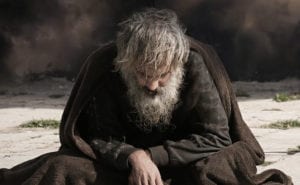For the next novel in your book club, you should consider On a Bright Hillside in Paradise, the winner of the 2022 Penguin Literary Prize: an absorbing and intimate novel that, to my surprise, described evangelical revivalistic spirituality with sensitivity and insight. It is a challenge to portray religious experience in a way that is neither cynical nor sentimental. In On a Bright Hillside in Paradise, Annette Higgs—who is not, as far as I know, a Christian herself—succeeds exceptionally well.
Based on Higgs’s own family history, this novel tells the story of the Hatton family, settlers in the Kentish district in North West Tasmania in the late nineteenth century. The novel begins with a giddy, sensory description of a revival meeting held in a barn by visiting Christian Brethren evangelists.[1]
From here, a close third-person narrator covers overlapping events from the perspective of five members of the family, varying the narrative voice slightly in each section, adding new events and information, as well as divergent perspectives on the same facts and occurrences; each time responding to the revival and its ongoing impact on the family and the wider rural community.
On a Bright Hillside bears the marks of diligent research, which is one of the pleasures of historical fiction. The novel is full of fascinating little details, such as reference to ‘badgers’ (wombats), the introduction of the overarm bowling technique to Tasmanian cricket, the mention of various bush remedies and the particulars of settler food and housing. Higgs shows great familiarity with Christian hymns and gospel songs from the era, as well as biblical passages, evangelical theology and revivalism practice.[2]
Focus on Historical and Perennial Questions
I was genuinely surprised that this prize-winning book from a major publisher did not focus on feminist themes or a critique of religious and church leaders; it did not feature any gay characters nor was it study of social class; while the stigma associated with convict heritage and relationships with indigenous Australians both featured, these were arguably not dominant themes. Exploring those themes has a place in literature, including historical fiction. And yet it was interesting to me that the author turned her attention elsewhere. Rather than focusing on major contemporary concerns, On a Bright Hillside devotes its attention to the pressing concern of its characters: their survival and establishment. In doing so, it also touches on other perennial questions of God, hope, death, time, love, family, guilt and community.[3] In this particular sense it could described as a conservative novel, which for award-winning fiction is, if not radical, perhaps unconventional.
The Appeal of Revivalism
The novel spends a great deal of time describing religious activity, experience and conversation, all from the point of view of its characters, their assumptions, ignorance, desires and needs. It shows the various reasons why people are drawn to religion without implying that psychological and social factors explain it away.
Higgs describes the intensity of revival meetings alongside more private religious experiences:
Jack recalled his emotions that night, the strange, surging sense of gratitude, as if someone had offered him a precious gift. He recalled the physical tightening all over his skin, the way his thoughts had swum in the dusty air, the ringing between his ears almost like a blow to the head. But what did those preacher fellows actually say? What did they want him to do? …
Unconsciously, he spoke his thoughts aloud.
“Lord, what must I do?”
An answer came to him—he heard it clearly, bell-like from the hot sky …
He that hears my word and believes on him that hath sent me, has everlasting life.
The preachers had spoken the same words, but to Jack they sounded like the words of the Lord himself. He fell to his knees, stunned.
“I am saved,” he said in an awestruck whisper. (p. 102)
Alongside these evangelical experiences, she also describes one of the children’s vivid sense of hearing the sound of fairies in the bush, and has another character liken religious feeling to sexual arousal. Other characters appreciate the power of revivalism even if they are entirely sceptical of its religious claims. The meetings remain entertainment for the ‘scoffers’—the full immersion creek baptisms more so, for the titillation of seeing women coming out of the water in their sodden clothes. All admire the skill of the evangelists. It is cute how both converts and scoffers alike regularly refer to the revival meetings as ‘a good show’.
Even though the ecstasy of the revival meeting wanes, especially when the evangelists move on, there is an ongoing impact on the lived experience of those who were touched by it. A new social pattern of Bible meetings and family devotion maintains the new spiritual life. In this, we see the positive social impacts of the Brethren’s work. The rural families are brought together in fresh and regular patterns by their newfound gospel faith. Eventually, they pool resources to build a Gospel Hall: a pinnacle achievement for the community, motivated by their shared religious life. Young men are empowered as local leaders and motivated to learn to read.
The revivalists also meet the practical needs of the settlers in the Kentish district, bringing knowledge of medicine, recipes, and news of the wider world. Further, the possibility that answered prayer might meet the desperate needs of a family waiting on a successful crop adds further interest in the evangelists.
The characters in this novel live close to subsistence and are so exposed to the elements that the risks of starvation, house fire, drowning while fording a swollen river, tuberculosis, death in childbirth, falling tree branches from ringbarked eucalypts, being accidentally shot or hopelessly lost in the bush are all acute concerns. The hope of eternal life and the longing to see one’s lost loved ones holds immense, visceral appeal. The longing for it to be true is portrayed with great intensity in the novel. The revivalists and their followers rightly connect this hope to faith in Christ and the forgiveness offered in the gospel. At the same time, there is a tendency to associate salvation with a particular conversion process advocated by the revivalists.
An Ecclesiology Suited to Remote Colonial Australia?
On a Bright Hillside reveals some of the reasons why the ecclesiological distinctives of the Brethren gained traction in this community. Noah, the father in the story, regularly emphasises that those in their circumstances “had to look after themselves” (p. 153)—not look to the colonial office, the city-dwelling Anglican ministers, the town-dwelling Wesleyans or even the Brethren evangelists. A church polity that emphasised the radical equality of all believers (albeit with a division between the sexes) is presented as ideally suited to remote, self-sufficient communities—“they say we don’t need no minister like the Anglicans—we can look after ourselves, they say!” (p. 32). The characters would be left waiting a long time for ordained ministers to arrive for official marriages and burials, let alone regular church services be conducted.
At several points Higgs has characters discern something illicit or transgressive in the allure of the Brethren and their practices. Grandmother Eliza, with faint memories of England and corresponding loyalty to the dignity of the Anglican Church, serves as a foil to this, further highlighting that life in the new world of Australia requires a new religious expression to match.
Limitations of Revivalism
The Christian Brethren defined themselves in reaction to established denominations such as the Church of England. Their message assumed that the culturally Christian community was not populated by genuine believers. Like much revivalism, their message and practice suggested that a particular experience and behaviour were necessary signs of genuine conversion. In this novel, that experience includes anxiety about sin, dramatic conversion, a capacity to articulate one’s faith in a particular form, and then receiving baptism by full immersion.
The appeal of their message was the simplicity, certainty and vivid reality of conversion which promised definite assurance of salvation. The risk with such a message is that salvation is grounded in the distinctives of revivalistic experience and practice, rather than the work of Christ:
Certainly Eliza herself would like another go at that stairway to heaven. When she thought back on that time, she felt she might’ve missed an opportunity. If only she could have got to the front, to that row of blue chairs, and had the preachers bend over and tell her how to be sure of being on the right side of the Lord when He came again. (p. 43)
The eccentricities and flaws of the evangelists and their Kentish converts are also on display in On a Bright Hillside. The narrators notice the signs of vanity, social awkwardness and lacklustre presentation of these would-be gentleman evangelists. Some characters even make dubious hints at their sobriety and idleness. The evangelists also betray their lack of understanding of the illiteracy of their audience:
He urged his listeners to heed only what the Bible said, and not to listen to those other clergymen, those of the established churches, who claimed to interpret the Bible…
“You can read for yourselves!” he said, forgetting the many among his audience who were not readers. (p. 169)
The remoteness of settler life is presented as forcing a pragmatic attitude on even the otherwise devout characters towards fornication, pregnancy and marriage. When ministers who might officiate weddings are absent, conception and even cohabitation might precede marriage in practice, even if it were considered the accepted and expected norm by the characters in the book.
Lastly, while religious revival has a largely positive effect on bringing the community together, it has the painful side effect of excluding those who do not convert— “You don’t want to be left out of things,” the unbelieving Eddie is warned by his younger sister Echo (p. 219). Higgs also alludes to the later development of the ‘Exclusive Brethren’, suggesting that the character who trends in that direction may be weaponising religion out of self-interested animosity.[4]
On a Bright Hillside in Paradise is a fascinating work for its rich and open approach to the evangelical Christian experiences of its characters. I wonder whether Australian society has become sufficiently post-Christian that it is able to now study Christian sub-cultures with respectful curiosity, free from a narrow politicised critical lens. Perhaps we will see the emergence of more work like this? I hope so.
It is also a beautiful and harrowing story told across three generations of a nineteenth-century Tasmanian family of limited means in remote and sometimes dangerous circumstances. Its exploration of themes, including the religious themes discussed above, is sophisticated but allows the characters and the story to remain in the foreground. Despite the heavy topics and life-altering events it covers, it is a quiet novel; the plot is not thick with intrigue. As the book’s blurb rightly describes: “Higgs takes lives that history might have judged as small and imbues them with dignity and complexity.”
[1] The Christian Brethren had a significant influence on Tasmania, especially but not exclusively in the North-West. Their legacy is still felt in the church scene of the early twenty-first century, especially when it is noted that some of today’s Pentecostal churches in Tasmania find their roots in the Brethren movement.
[2] I understand that The Brethren History Review plans to publish a review of the novel. I will be interested to hear an expert assessment of its accuracy.
[3] This is not to say that race, class, sex and sexuality, and the politics of these themes, are not also perennial questions.
[4] ***Light spoiler*** The narrative could be seen as being complicit in this exclusion, insofar as certain characters are ‘punished’ by the plot for their rejection of the commity’s conversion.














